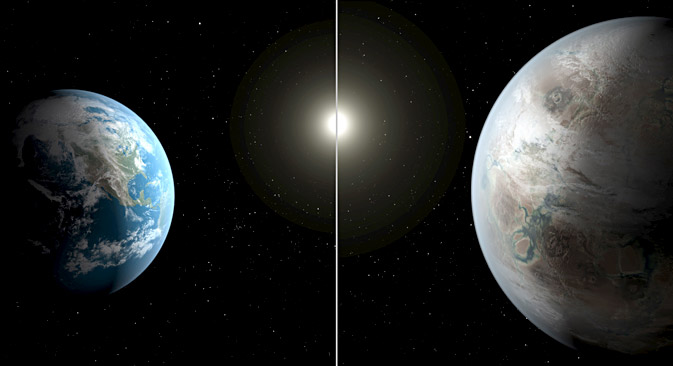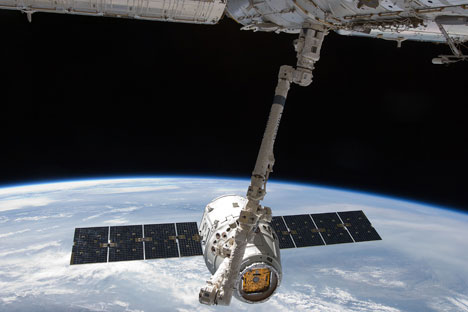Is there life on 'Earth-2'?

An artistic illustration compares Earth (L) to a planet beyond the solar system that is a close match to Earth, called Kepler-452b in this NASA image released on July 23, 2015. Source: Reuters
The discovery in late July of exo-planet Kepler-452b by NASA’s Kepler space telescope caused a stir in the international scientific community. Exo-planets orbit a star other than our Sun, and a third of those discovered so far are located in the so-called “habitable zone,” which is calculated as roughly the same distance from the planet to its star as the Earth is to the Sun. This indicates that conditions could be similar to those on Earth.
Kepler-452b, however, is more interesting than most planets in the habitable zone because it has so much in common with our world; thus, it has already been dubbed “Earth-2.’’ Its trajectory, its age (about 6 billion years old), the time it takes to orbit its star (385 days), and the possible existence of water — all indicate that the planet can support life just like on Earth.
'About a 100 Earth-like planets'
There is another reason scientists are so interested in the recently discovered planet --- the bright star that it orbits, called Kepler-452b, is very similar to our Sun. Other Kepler-detected exo-planets located in the habitable zone orbit red dwarf stars which are much cooler in temperature.
The planet Kepler-452b is also unique because of its size, which is much closer to Earth’s than most other exo-planets. Russian astronomers, however, caution that there are plenty of other Earth-sized planets, and one need not look far. Venus and Mars are two excellent examples, and neither hosts life as far as we know. So, before anyone can claim that the new planet can support life researchers will first have to analyze its atmosphere, among other things.
“Planets that have similar temperature conditions to Earth have been found before, and there are about a 100 of those; but in this case, it is the size that is really interesting,” said Lev Zelyony, head of the Russian Academy of Science’s Space Research Institute. “Additionaly, provided the planet is located at a certain distance away from a star of certain brightness, there certainly is a possibility it could support a biosphere similar to our own.”
According to Alexander Bagirov, researcher at the solar system dynamics department at the Russian Academy of Science’s Astronomy Institute, quite a few celestial bodies in our universe could be habitable.
“But there is another question – is there sentient life on this or that body? And this is much more difficult to determine,’’ said Mr. Bagirov. “After all, we do not even completely understand the laws according to which life has evolved on our planet. Scientists believe the emergence of life is impossible on planets without satellites, such as our Moon, which caused tides that at some point allowed Earth's nascent life forms to emerge from the ocean to land.
Any signs of sentient aliens?
“Everyone assumed that there must be planets that are more or less similar to Earth, but this one is not a gas giant; it is solid and not too big,” Russian astronomer Valentin Esipov told RBTH. “Now it is imperative to determine if the planet has a magnetic field, as well as any water reserves on its surface.”
As the Russian Academy of Science’s astronomy council president Nikolay Kardashev points out, researchers will have to examine Kepler-452b closely and determine if it has an atmosphere before the existence of life can even be brought up. The Kepler telescope, however, is simply not powerful enough for such a task.
“A new, bigger telescope will be launched in the coming years, and we will soon be able to explore Kepler-452b further to discover if it has an atmosphere or water,” said Mr. Kardashev. “So far this task is too difficult because of the distance between us and the planet.”
Kepler-452b is 2 million times farther away from Earth than the planet Neptune. According to Sergey Bogachev, senior research fellow at the Lebedev Physical Institute, a hypothetical spaceship traveling at the speed of light will take about 1500 years to get there.
Nikolay Kardashev believes that even if some kind of signal had been sent to Earth from Kepler-452b, a whole new generation of observation devices will be needed to detect it. Such technology might emerge thanks to an initiative launched by Russian entrepreneur, Yuri Milner, who recently announced his intention to invest $100 million in the search for extraterrestrial life, partnering with the famous British physicist Stephen Hawking.
All rights reserved by Rossiyskaya Gazeta.
Subscribe
to our newsletter!
Get the week's best stories straight to your inbox
